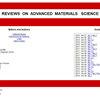Mechanical properties of seawater volcanic scoria aggregate concrete-filled circular GFRP and stainless steel tubes under axial compression
IF 3.6
4区 材料科学
Q2 MATERIALS SCIENCE, MULTIDISCIPLINARY
引用次数: 0
Abstract
In this study, the properties of seawater volcanic scoria aggregate concrete (SVAC)-filled circular stainless steel (SFCST) and glass fibre-reinforced plastic (GFRP) tubes (SFCGT) were investigated. Ten groups were considered and 30 specimens were prepared, including four different parameters: the concrete type (SVAC and ordinary concrete [OC]), outer tube type (GFRP and stainless steel tubes), concrete strength (C30 and C40), and tube thickness (0, 3, and 4 mm). The typical influences of the SVAC and outer tube on the mechanical properties of specimens were then analysed. The research findings show that the strength and ductility of the SFCGT and SFCST are significantly higher than those of plain SVAC. The peak strain and strength enhancement factor of the SFCGT and SFCST increase with an increase in the tube thickness, and the concrete strength has a detrimental impact on the toughness of the specimen. Unlike in the confined OC specimens, a sudden decrease is observed in the stress–strain curves of the SFCGT and SFCST owing to the changes in the deformability of the SVAC. Generally, the strengths of the SFCGT and SFCST specimens are 10.3% lower and 4.1% higher than those of the confined OC specimens, respectively. Finally, analytical models of the strength and stress–strain curves considering the influences of the SVAC and passive confinement were established, and numerical simulations were performed to provide a basis for the practical application of the SFCGT and SFCST.海水火山碎屑骨料混凝土填充的圆形玻璃纤维增强塑料管和不锈钢管在轴向压缩下的力学性能
本研究调查了海水火山碎屑骨料混凝土(SVAC)填充圆形不锈钢管(SFCST)和玻璃纤维增强塑料管(GFRP)(SFCGT)的性能。共考虑了 10 组,制备了 30 个试样,包括四个不同的参数:混凝土类型(SVAC 和普通混凝土 [OC])、外管类型(玻璃纤维增强塑料管和不锈钢管)、混凝土强度(C30 和 C40)以及管厚度(0、3 和 4 毫米)。然后分析了 SVAC 和外管对试样力学性能的典型影响。研究结果表明,SFCGT 和 SFCST 的强度和延展性明显高于普通 SVAC。SFCGT 和 SFCST 的峰值应变和强度增强因子随着管厚度的增加而增加,而混凝土强度对试样的韧性有不利影响。与密闭 OC 试件不同的是,由于 SVAC 变形能力的变化,SFCGT 和 SFCST 的应力-应变曲线会突然下降。一般来说,SFCGT 和 SFCST 试样的强度分别比密闭 OC 试样低 10.3% 和高 4.1%。最后,考虑到 SVAC 和被动约束的影响,建立了强度和应力-应变曲线的分析模型,并进行了数值模拟,为 SFCGT 和 SFCST 的实际应用提供了依据。
本文章由计算机程序翻译,如有差异,请以英文原文为准。
求助全文
约1分钟内获得全文
求助全文
来源期刊

Reviews on Advanced Materials Science
工程技术-材料科学:综合
CiteScore
5.10
自引率
11.10%
发文量
43
审稿时长
3.5 months
期刊介绍:
Reviews on Advanced Materials Science is a fully peer-reviewed, open access, electronic journal that publishes significant, original and relevant works in the area of theoretical and experimental studies of advanced materials. The journal provides the readers with free, instant, and permanent access to all content worldwide; and the authors with extensive promotion of published articles, long-time preservation, language-correction services, no space constraints and immediate publication.
Reviews on Advanced Materials Science is listed inter alia by Clarivate Analytics (formerly Thomson Reuters) - Current Contents/Physical, Chemical, and Earth Sciences (CC/PC&ES), JCR and SCIE. Our standard policy requires each paper to be reviewed by at least two Referees and the peer-review process is single-blind.
 求助内容:
求助内容: 应助结果提醒方式:
应助结果提醒方式:


